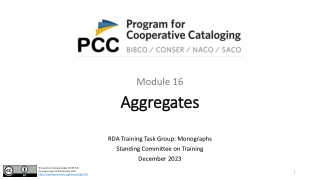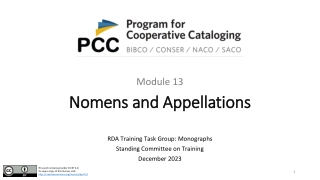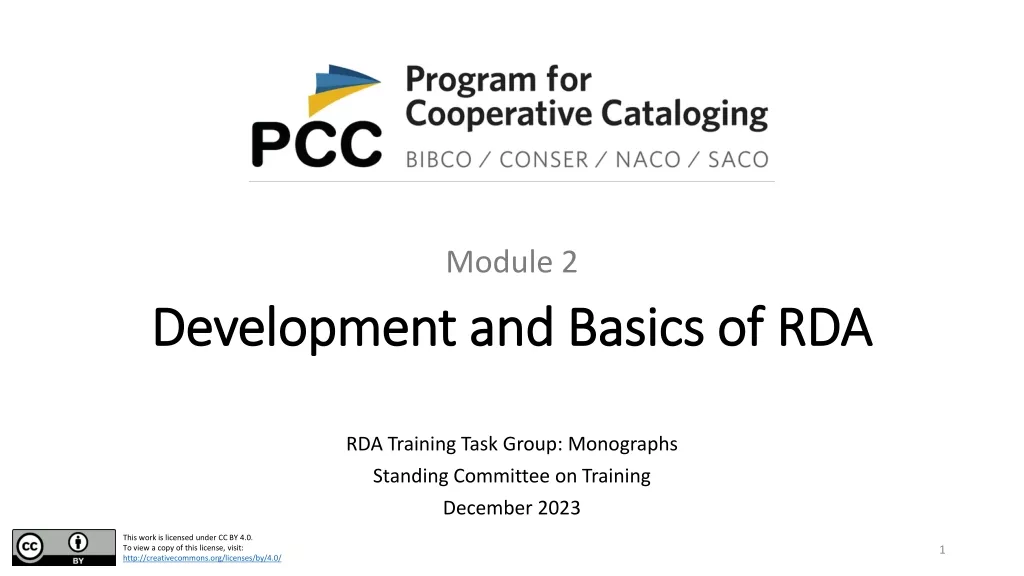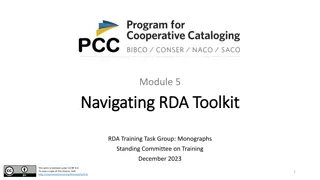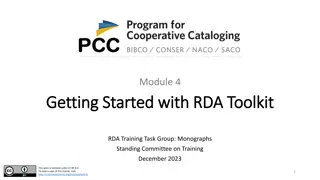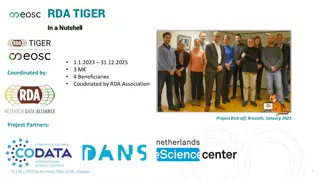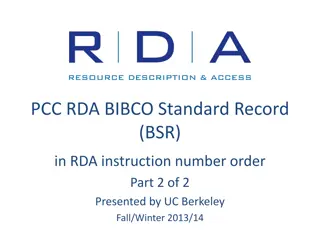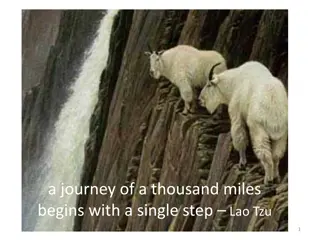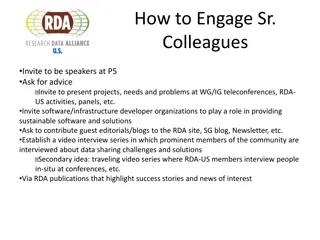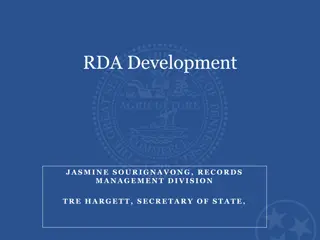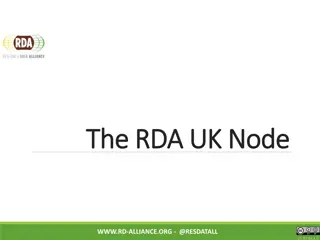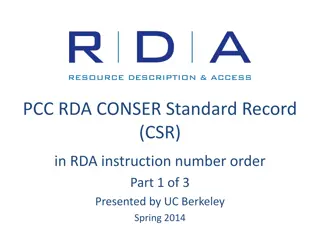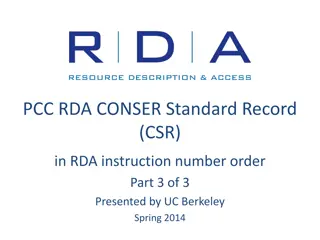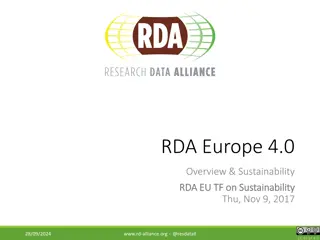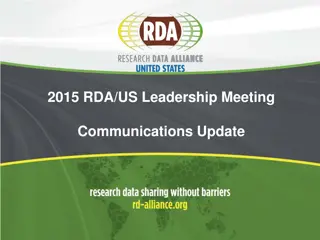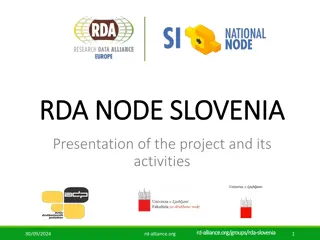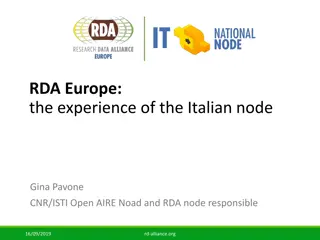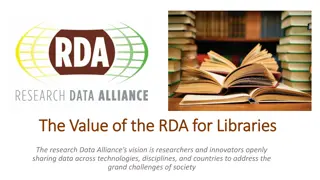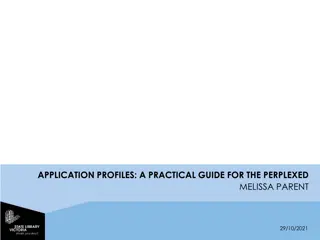Understanding Relationships in Resource Description and Access (RDA)
Delve into the intricate web of relationships between resources and persons/families/corporate bodies as outlined in RDA guidelines. Explore the roles of creators, contributors, and compilers in the creation of works, manifestations, and items. Learn about recording creator relationships in MARC fields and the nuances of performers as creators, including corporate bodies.
Download Presentation

Please find below an Image/Link to download the presentation.
The content on the website is provided AS IS for your information and personal use only. It may not be sold, licensed, or shared on other websites without obtaining consent from the author. Download presentation by click this link. If you encounter any issues during the download, it is possible that the publisher has removed the file from their server.
E N D
Presentation Transcript
Identifying and Recording Relationships Raymond Schmidt Wellesley College
Three sets of relationships between FRBR entities How resources relate to persons, families, and corporate bodies Chapters 18-22, Appendix I How resources relate to other resources (work, expression, manifestation, item) Chapters 24-28, Appendix J How persons, families, and corporate bodies relate to each other Chapters 29-32, Appendix K
Relationships between resources and persons/families/corporate bodies
Instructions in RDA Persons/families/corporate bodies associated with a Work (Chapter 19): creators, others Expression (Chapter 20): contributors Manifestation (Chapter 21) Item (Chapter 22)
Creator A creator is a person, family, or corporate body responsible for creation of a work. Core: creator having principal responsibility named first on the resource Best practice: record all creators
Creators of musical works composer librettist lyricist compiler (?) These are all terms from Appendix I.2.1 in RDA.
Recording creator relationship in MARC MARC field 100 or 110 as an authorized access point Terms in RDA appendix I.2.1 are given in $e (prefer over $4 relator codes) Additional creators are given in 700 or 710 fields 100 1# Higdon, Jennifer, $d 1962- $e composer
Performers as creators? AACR2 RDA Performer main entry for sound recordings of works by different persons or bodies (21.23C, 21.23D) Much more common for popular, rock and jazz Corporate body as creator (19.2.1.1.1) Improviser (6.28.1.5.1) Compiler? (19.2.1.1)
Performers as creators corporate bodies AACR2 21.23D1 If the item being catalogued contains works that are of a type in which the participation of the performer(s) goes beyond that of performance, execution, or interpretation (as is commonly the case in popular, rock, and jazz music), enter under the heading for the person or body represented as principal performer. RDA 19.2.1.1.1 Corporate bodies are considered to be creators when they are responsible for originating, issuing, or causing to be issued, works that fall into one or more of the following categories: d) works that result from the collective activity of a performing group as a whole where the responsibility of the group goes beyond that of mere performance, execution, etc.
Performers as creators? Examples in 19.2.1.1.1, Corporate bodies considered to be creators: Coldplay ( Songs written by Coldplay and performed by them ) Red Hot Chili Peppers ( Songs composed by the rock group ) Nils-Bertil Dahlander Quartet, Paul Hindberg Quintet ( two jazz groups )
Performers as creators of derived new works (adaptations) RDA 6.28.1.5.1 Categories of adaptations of musical works a) arrangements described as freely transcribed, based on, etc., and other arrangements incorporating new material b) paraphrases of various works or of the general style of another composer c) arrangements in which the harmony or musical style of the original has been changed d) performances of musical works involving substantial creative responsibility for adaptation, improvisation, etc., on the part of the performer or performers e) any other distinct alteration of another musical work
Performer as compiler? RDA 19.2.1.1 A person, family, or corporate body responsible for compiling an aggregate work may be considered to be a creator of the compilation if the selection, arrangement, editing, etc., of content for the compilation effectively results in the creation of a new work
Contributors to musical expressions arranger of music editor performer conductor, instrumentalist, singer transcriber translator These are all terms from Appendix I.3.1 in RDA.
Recording contributor relationship in MARC MARC field 700 or 710 as authorized access points Terms in RDA appendix I.3. 700 1# Hess, Myra, $c Dame, $d 1890-1965, $e arranger of music.
Instructions in RDA Related works (Chapter 25): adaptation, supplement, part of a larger work Related expressions (Chapter 26): translation Related manifestations (Chapter 27): facsimile, reprint Related items (Chapter 28)
Methods for expressing relationships Authorized access point + relationship designator Structured description Unstructured description Identifiers (not used in the current MARC environment)
Derivative works Authorized access points coded as related works (700 1#) with relationship designators from appendix J given in $i 700 1# $i Musical variations based on (work): $a Paganini, Nicolo, $d 1782-1840. $t Caprices, $m violin, $n M.S. 25. $n No. 24 700 1# $i Libretto based on (work): $a Williams, Tennessee, $d 1911- 1983. $t Streetcar named Desire 700 1# $i Cadenza composed for (work): $a Mozart, Wolfgang Amadeus, $a 1756 1791. $t Concertos, $m flute, orchestra, $n K. 313, $r G major
Work-work relationship in authority record 100 1# Brahms, Johannes, $d 1833-1897. $t Variationen ber ein Thema von Paganini 500 1# $i Musical variations based on (work): $a Paganini, Nicolo, $d 1782-1840. $t Caprices, $m violin, $n M.S. 25. $n No. 24 $w r
Compilations Ideally, authorized access points for each work, but only for Western art music Contains is implicit in MARC coding 700 12, but PCC recommends adding relationship designator in $i 700 12 $i Contains (work): $a Cumming, Richard. $t Silhouettes. 700 12 $i Contains (work): $a Cumming, Richard. $t Postcards from Italy. 700 12 $i Contains (work): $a Cumming, Richard. $t Holidays. 700 12 $i Contains (work): $a Cumming, Richard. $t Knight's page. 700 12 $i Contains (work): $a Cumming, Richard. $t We happy few. Structured description in contents note (MARC 505)
Facsimiles and reprints Structured description 500 Reprint. Originally published: Milano ; New York : G. Ricordi, 1913. Unstructured description 500 Facsimile of manuscript, Dendermonde St.-Pieters & Paulusabdij, Codex 9. Linking entry 775 08 $i Reprint of (manifestation): $a Verdi, Giuseppe, 1813-1901. $t Aida. $b Nuova ed. riveduta e corretta. $d Milano : Ricordi, c1913 $w (OCoLC)15115598
Other unstructured descriptions in notes Different manifestations of the same expression 500 The 5th work previously released by Cambridge Records (CRS 2778). Different versions of the same work 500 Although this score represents the original 1911 orchestration, it also contains the concert ending from the 1947 version as an alternate ending. Referencing the original source for an arrangement 500 Originally for viola and piano.
Relationships between persons, families, and corporate bodies
Instructions in RDA Related persons (Chapter 30) Related families (Chapter 31) Related corporate bodies (Chapter 31)
Related persons recorded in MARC Access point in authority record with relationship designator from appendix K in $i 110 2_ Rolling Stones 500 1_ $i Group member: $a Jagger, Mick $w r 500 1_ $i Group member: $a Richards, Keith, $d 1943- $w r
Group exercises Identifying and recording relationships
For the following resources, what are the relationships within each resource, and between the resource and other resources? How would you express the relationships: authorized access point, structured description, and/or unstructured description? How is this done in MARC?
Compact disc label: 1-3 Copland: Duo for flute and piano 4-8 Barber: M lodies passag res, op. 27 9 Barber: Canzone, op. 38 10 Harris: Lyric study for flute and piano 11-13 Beaser: Variations for flute and piano AMERICAN MASTERWORKS WITH TIMOTHY HESTER, PIANO PAULA ROBISON, FLUTE On container: Paula Robison plays American Masterworks Additional information: M lodies passag res, arranged for flute and piano, was originally a set of five songs for voice and piano.
AMERICAN MASTERWORKS This is a compilation of 5 works by 4 different creators: Copland, Barber, Harris, Beaser. To express parts of the whole: Structured description in contents note, placed in 505. Analytical AAPs for all 5 works, each placed in 700 12. The 2nd work is an arrangement (derivative expression). Include $o arranged in AAP. Provide an unstructured description in 500 note: 2nd work originally a set of five songs for voice and piano. Robison (flute) as contributor: AAP placed in 700 (not 100, because Robison is not a creator). Indicate relationship using term from Appendix I (either performer or instrumentalist), placed in $e. Hester (piano) as contributor: AAP placed in 700. Indicate relationship using term from Appendix I (either performer or instrumentalist), placed in $e.
Score title page: Michael Nyman THE MAN WHO MISTOOK HIS WIFE FOR A HAT chamber opera Libretto by Oliver Sacks, Christopher Rawlence and Michael Morris after The Man Who Mistook His Wife For A Hat by Oliver Sacks Full Score Original title of the book that the opera is based on: The man who mistook his wife for a hat and other clinical tales.
Michael Nyman The man who mistook his wife for a hat Nyman as creator: express using AAP for Nyman, placed in 100, followed by the term composer from Appendix I, placed in $e. Additional creators: Librettists Sacks, Rawlence, and Morris. AAP placed in 700 for each. Indicate relationship using term librettist from Appendix I, placed in $e. The opera is a derivative new work. Express using AAP for the original work, coded 700 1# for a related work, preceded by a term from Appendix J, placed in $i: 700 1# $i Libretto based on (work): $a Sacks, Oliver W. $t Man who mistook his wife for a hat and other clinical tales.
Score title page: Claude Debussy Pelle as et Me lisande in Full Score Dover Publications, Inc., New York Verso of title page: This Dover edition, first published in 1985, is an unabridged republication of the work originally published by E. Fromont, Editeur, Paris, in 1904. P. iii: Lyric drama in 5 acts by Maurice Maeterlinck.
Claude Debussy Pelle as et Me lisande Debussy as creator: express using AAP for Debussy, placed in 100, followed by term (composer) from Appendix I, placed in $e. Additional creator: Maeterlinck. AAP placed in 700. Indicate relationship using term from Appendix I (librettist), placed in $e. This is a reprint of an earlier manifestation. Use structured or unstructured description placed in 500 note. Optionally, use a linking entry field instead, placed in 775 field, including term in $i from Appendix J: 775 08 $i Reprint of (manifestation):
Score title page: Richard Wagner Tannh user WWV 70 Edited by / Herausgegeben von Peter Jost Preface: Inasmuch as the Vienna version reflects the score used at the final production of Tannh user that Wagner himself oversaw in 1875, this is the version that has been preferred for the present edition.
Richard Wagner Tannh user Wagner as creator: express using AAP for Wagner, placed in 100, followed by two terms, composer and librettist, from Appendix I, placed in $e: 100 1 Wagner, Richard, $d 1813-1883, $e composer, $e librettist. Jost as contributor: AAP placed in 700. Indicate relationship using the term editor from Appendix I, placed in $e. The preface indicates that this score appears in different versions. Use an unstructured description in a 500 note; either quote from the preface, or simplify as: 500 Vienna version (1875).
Score title page: 15 recital songs in English Songs by Argento, Britten, Copland, Finzi, Head, Ireland, Quilter, Rorem, and Vaughan Williams Table of contents: Dominick Argento : Dirge Benjamin Britten: The ash grove, O waly, waly, The Salley Gardens Aaron Copland: At the river, Simple gifts Gerald Finzi: Fear no more the heat o' the sun, Oh fair to see Michael Head: Money, O! John Ireland: Spring sorrow Roger Quilter: Drink to me only with thine eyes, Weep you no more Ned Rorem: Little elegy, Love Ralph Vaughan Williams: Bright is the ring of words
15 recital songs in English This is a compilation of 15 works by 9 different creators. To express parts of the whole: Structured description in contents note, placed in 505. Optionally, analytical AAPs for all 15 works, each placed in 700 12. Discussion point: how many AAPs before it becomes burdensome ?
Compact disc label: Seven mad gods Robert Maggio Winter Toccata Two Quartets Barcarole Container: Winter toccata (I can't believe you want to die) (21:53) John Koen, cello Two quartets (desire, movement, love, stillness) (21:19) Bart Feller, flute, Kathleen Nester, flute, Fred Sherry, cello, Jonathan Spitz, cello, Bradley Lubman, conductor Barcarole (seven mad gods who rule the sea) (19:35) Scott St. John, violin, John Koen, cello, Hugh Sung, piano, Don Liuzzi, percussion, Jennifer Higdon, conductor Note: The 3rd work is a ballet, based on Mendelssohn's Songs without words, op. 19, no. 6.
Robert Maggio Seven mad gods Maggio as creator: express using AAP for Maggio, placed in 100, followed by the term composer from Appendix I, placed in $e. Conventional collective title in 240: Instrumental music. $k Selections Contributors: AAPs for all performers, placed in 700. Indicate relationship using term from Appendix I, placed in $e. To express parts of the whole: Structured description in contents note, placed in 505. Analytical AAPs for all 3 works, each placed in 700 12. The 3rd work is a derivative new work. Express using AAP for the original work, coded 700 1# for a related work, preceded by a term from Appendix J, placed in $i: 700 1# $3 Third work $i Adaptation of (work): $a Mendelssohn- Bartholdy, Felix, $d 1809-1847. $t Lieder ohne Worte, $m piano, $n op. 19b. $n Nr. 6, $p Venetianisches Gondellied.


